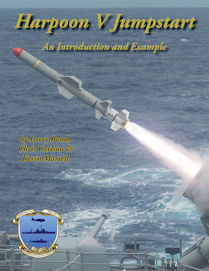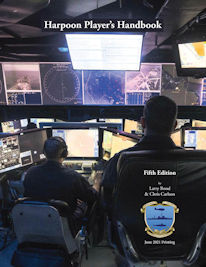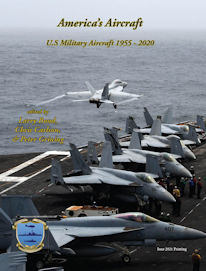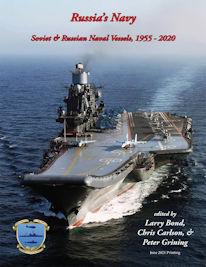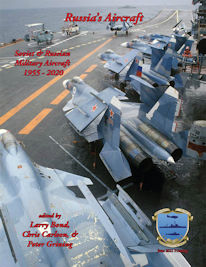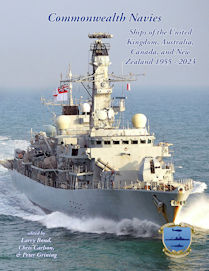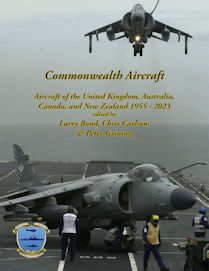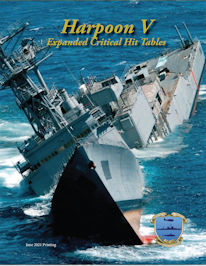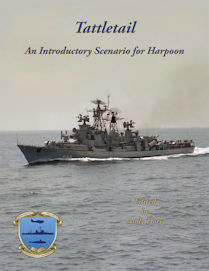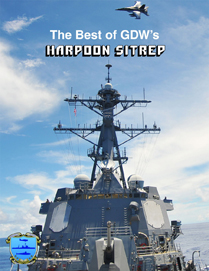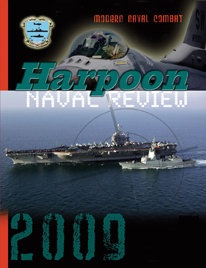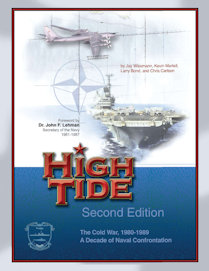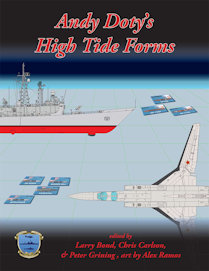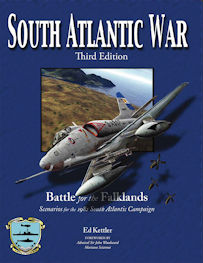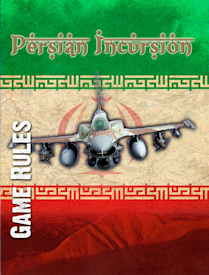- HARPOON -
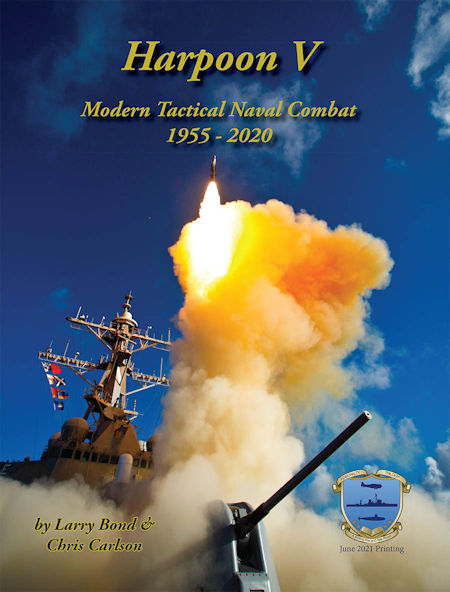 Harpoon
Harpoon is a tactical miniatures game that covers all aspects of naval warfare from 1955 to the present day: surface, sub-surface, and air. Extensively researched and tested, the rules allow play so realistic the game has been used for training by the U.S. and other navies.
Harpoon uses the same format and terms as other
Admiralty Trilogy games. This allows players familiar with those games, and naval combat of earlier time periods, to easily step into the modern era.
Harpoon explains the essentials of a wide range of sensors and the virtually intelligent weapons used in modern naval combat. Sidebars explain what's going on "under the hood" in some of the game's mathematical models, as well as background information on the tactics and technology of the hardware. Although good admirals will know the capabilities of their own hardware, as well as those of the enemy, the game emphasizes the decisions that the players must make as naval commanders, giving them the same type of information naval officers would have in the real world and presenting them with the same choices.
Players can use
Harpoon to game out now-historical Cold War scenarios, real-world naval crises, or explore the possibilities of advanced weapons systems.
The fifth edition builds on decades of game design experience to provide simplified game play, while adding 21st -century systems like antiship ballistic missiles, ballistic missile defense, and unmanned vehicles. It also takes advantage of the mountain of data now available from foreign sources, and declassified material in U.S. Navy archives.
Click here for a
History of the Harpoon System.
Existing fourth-edition products will be updated as quickly as possible to the new fifth edition standard. These include
High Tide, covering US and Soviet Cold War forces,
South Atlantic War, the Falklands conflict, and
Dance of the Vampires, an historical document that shows how Harpoon was used when researching and writing Red Storm Rising.
Information on the platforms, weapons, and sensors used in Harpoon will be provided in the new Navies series. The first two sets, paired booklets entitled
America's Navy, America's Aircraft, Russia's Navy, and
Russia's Aircraft, will be released with the fifth edition rules, and followed by other navies as quickly as the data can be compiled.
To support
Harpoon, as well as the other three core games, we also publish our
Naval Sitreps to keep our players up to date.
Harpoon fifth edition is the latest version of an award-winning series that began with its original release in 1980. In addition to updating and simplifying the rules for modern tactical naval and aerial combat, the fifth edition now includes naval combat system development, mines, ballistic missile attacks and defense, unmanned vehicles, land-attack cruise missiles, non-acoustic ASW sensors, as well as other improvements. Harpoon uses the designers' extensive game design and naval warfare experience to create a game that is authentic, informative, and exciting.
Harpoon is a tactical game about modern naval warfare. The fifth edition builds on the success of earlier editions by adding 21st Century developments like antiship ballistic missiles and unmanned vehicles, as well as simplified rules for aircraft endurance, AAW, air combat, and other complex processes. The rules cover naval warfare from 1955 through the present day, with surface ships, submarines, and aircraft accurately described.
This Jumpstart is a free introdution to the new fifth edition version of Harpoon. It includes a rules summary and a sample scenario, diagrammed and heavily annotated to explain play. The summaries cover the basics of game play and important changes from earlier editions of the game. We encourage you to download it, share with anyone who might be interested, and please email us at adtrgroup@aol.com with any questions or comments.
This Player's Handbook for Harpoon fifth edition collects all the tables in the rules and organizes them for quick reference to speed play. It is not a complete rules set, but players can use the handbook to consult rules tables without having to pass a rules book back and forth.
America’s Navy lists all the US Navy warships in service between 1955 and the present day, as well as some US Coast Guard ships and other vessels. It is designed as a sourcebook for Harpoon, fifth edition, but it can also be used as a general reference. Organized as a collection of annexes, Annex A provides statistics on ships as built, and any modifications and refits over time, sometimes many times. Annexes C and on give detailed weapons and sensors characteristics, including guns, missiles, ASW weapons, radars, sonars, with all the information needed to used them in a Harpoon scenario. A new feature of this edition is information on air groups used by aviation ships. Annex R, by Andy Doty, is the most complete list available anywhere, and provides data on units, aircraft types, and number of aircraft for each deployment.
In addition to real-world platforms, many canceled or proposed ships and their systems are also described. The book also provides information on land-based surface-to-air missiles system specifications and organization. Supplemental annexes list ship classifications and factors used to convert weapons and sensor information into game data.
America’s Aircraft lists the US Navy, US Coast Guard, and US Air Force aircraft in service between 1955 and the present day. It is designed as a sourcebook for Harpoon, fifth edition, but it can also be used as a general reference. Organized as a collection of annexes, this publication provides statistics on aircraft and any modifications or upgrades they received, sometimes many times. Other annexes detail weapons and sensors characteristics, including air-to-air and air-to surface missiles, guns, ASW weapons, electronics pods, radars, sonars, with all the information needed to use them in a Harpoon scenario.
In addition to real-world platforms, many canceled or proposed aircraft and their systems are also described.
Russia’s Navy lists all Soviet and Russian warships in service between 1955 and the present day, as well as some Border Patrol ships and other vessels. It is designed as a sourcebook for Harpoon, fifth edition, but it can also be used as a general reference. Organized as a collection of annexes, Annex A provides statistics on ships as built, and any modifications and refits over time, sometimes many times. Annexes C and on give detailed weapons and sensors characteristics, including guns, missiles, ASW weapons, radars, sonars, with all the information needed to use them in a Harpoon scenario.
In addition to real-world platforms, many canceled or proposed ships and their systems are also described. The book also provides information on land-based radars, coastal anti-ship and surface-to-air missile specifications and battery organization. Supplemental annexes list ship classifications and factors used to convert weapons and sensor information into game data.
Russia"s Aircraft lists aircraft in service between 1955 and the present day in Naval Aviation (AVMF), the Military Air Force (VVS), and the Air Defense Forces (PVO), and Long-Range Aviation (DA). It can be used as a sourcebook for Harpoon, fifth edition. Organized as a collection of annexes, it provides statistics on aircraft and any modifications or upgrades they received, sometimes many times. Other annexes detail weapons and sensors, including air-air-to-air and air-to surface missiles, guns, ASW weapons, electronics pods, radars, sonars, with all the information needed to use them in a Harpoon scenario.
In addition to real-world systems, many canceled or proposed weapons are also described, as well as UAVs and reconnaissance drones.
China's Navy lists the ships and aircraft used by the People's Liberation Army Navy and Air Force and Chinese Coast Guard, in service between 1955 and the present day. It is designed as a sourcebook for Harpoon, fifth edition, but it can also be used as a general reference. Organized as a collection of annexes, Annexes A and B provide statistics on ships and aircraft respectively as first built, and any modifications over time, sometimes many times. Annexes C and on give detailed weapons and sensors characteristics, including guns, missiles, antisubmarine weapons, torpedoes, mines, airborne ordnance, radars, sonars, and data links, with all the information needed to use them in a Harpoon scenario.
The book also provides information on land-based surface-to-air missiles and coastal defense missiles and their battery organization. Supplemental annexes list ship classifications and factors used to convert weapons and sensor information into game data.
Commonwealth Navies lists all the British, Australian, Canadian, and New Zealand warships in service between 1955 and the present day. It is designed as a sourcebook for Harpoon, fifth edition, but it can also be used as a general reference. Organized as a collection of annexes, Annex A provides statistics on ships as built, and any modifications and refits over time, sometimes many times. Annexes C and on give detailed weapons and sensors characteristics, including guns, missiles, ASW weapons, radars, sonars, with all the information needed to use them in a Harpoon scenario. A new feature of this edition is information on air groups used by aviation ships. Annex R, by Andy Doty, is the most complete list available anywhere, and provides data on units, aircraft types, and number of aircraft for each deployment.
In addition to real-world platforms, many canceled or proposed ships and their systems are also described. The book also provides information on land-based surface-to-air missiles system specifications and organization. Supplemental annexes list ship classifications and factors used to convert weapons and sensor information into game data.
Commonwealth Aircraft lists the British, Australian, Canadian, and New Zealand aircraft in service between 1955 and the present day. It is designed as a sourcebook for Harpoon, fifth edition, but it can also be used as a general reference. Organized as a collection of annexes, this publication provides statistics on aircraft and any modifications or upgrades they received, sometimes many times. Other annexes detail weapons and sensors characteristics, including air-to-air and air-to surface missiles, guns, ASW weapons, electronics pods, radars, sonars, with all the information needed to use them in a Harpoon scenario.
In addition to real-world platforms, many canceled or proposed aircraft and their systems are also described.
This free publication supports the Harpoon V modern naval tactical rules set. It provides a detailed breakdown of each column of the Critical Hit Table, using a D100 roll instead of a D20. Each ship type has a separate page, and details of each casualty are included.
This is a straight implementation of the Harpoon V rules, with the exception of two changes that (as of March 2021) will be incorporated in the next upload of the rules, and an unofficial “house rule” that provides an alternate scheme for ships built during the CaS era (before 1955).
Tattletail is an introductory scenario for the Harpoon V game system. Set in 1991, Standing Naval Force Atlantic (STANAVFORLANT) is being shadowed by a Russian destroyer during a time of rising tensions between Russia and NATO. At the start of the scenario, the Russian vessel receives orders to attack.
Form 10s with complete data on all ships and aircraft are provided in the supplement.
Updated 10AUG2024
GDW's Harpoon SITREP was published quarterly between January 1989 to January 1994. Each issue provided a mix of scenarios, articles on naval warfare and technology, and statistics on weapons systems. All this was designed to support the very active Harpoon miniatures gaming community, and was supported by them. Most of the bylines in each issue were of players who wanted to share a new idea, or their expertise, about a part of the game.
The issues are long out of print, but demand for back issues has been steady, and photocopies of the old issues are steady sellers.
After four editions of Harpoon and twelve years, a lot of the articles are dated, but there is still a lot of good information - general pieces on naval warfare, book reviews, and scenarios. This book gathers together the best of those issues in one place.
While a few of the articles have been updated, most are untouched. We've limited changes to replacing or improving graphics, using current statistics, and removing any inconsistencies with current rules. These are peripheral issues and in no case was the content of the article changed.
When formulating their strategies, the world's navies always plan to put their best forces in position to deal with any problem. However, reality rarely cooperates with these plans and naval forces often find themselves faced with situations for which they are not be prepared.
From hypothetical Cold War actions to current encounters and potential future conflicts, Harpoon Naval Review 2003 provides scenarios that let you explore how ad hoc naval groups deal with these situations. It also presents scenarios and articles covering naval items of interest from around the world; with ship and aircraft forms for the scenarios.
Harpoon Naval Review 2003 contains articles on Australia's Navy in the 21st Century, The Chinese Navy, A Tour of a Project 641 [Foxtrot] Class submarine, Optional Variable Damage Rules, Weapon Arcs vs. Director Arcs, and nine scenarios.
Modern Naval technology is evolving at a rapid pace and the potential for conflict on the world's seas is as high as ever, creating scenarios, both real and hypothetical, that can be played out with the Harpoon game system.
Harpoon Naval Review 2009 comes with 49 ship and 52 aircraft forms, all updated with the latest standardized Admiralty Trilogy information, scenarios, after-action reports, and more.
Dance of the Vampires is a combination scenario book/after-action report of several wargames that were played during the writing of the military thriller Red Storm Rising, by Tom Clancy and Larry Bond. The book’s story-line had been roughed out and the high point of the first act was to be regimental-sized Backfire strike on a NATO carrier battle group. This was something the Soviets talked about a lot, and NATO worried about just as much. It was decided that the best way to explore the possibilities was by using Harpoon to game out the attack. This product describes the Harpoon games that were developed to explore this scenario, including the forces involved and narrative accounts of what happened the three times the game was played. This edition also includes a write-up of the Keflavik Turkey Shoot, the scenario that spawned the idea of that having the Soviets invade Iceland was necessary. This invasion formed one of the key plotlines of the novel.
High Tide, 2nd edition is a scenario supplement for the tactical naval miniatures game Harpoon V.
It is is a collection of scenarios covering the Cold War naval confrontation between the US/NATO and the USSR/Warsaw Pact at the end of the 1980s, when both navies were at their peak of power.
First released by Clash of Arms in 2003, it has been updated using twenty years of new history, as well as converting it to be compatible with Harpoon V.
In addition to scenarios and historical sidebars, it has annex data for non-US, UK, or Russia countries (already covered in ATG's Navies series annex books) in NATO and the Warsaw Pact, such as France, Italy, East Germany, and Poland. Only those "rest of the world" ships that are required for the scenarios are included, but all the data for their weapons and sensors is included.
This supplement includes 187 Form 10s from 162 ship classes and 84 aircraft Form 20s that appear in scenarios of High Tide, Second Edition, a supplement for Harpoon, Fifth Edition.
High Tide is a collection of scenarios covering the naval confrontation between the US/NATO and the USSR/Warsaw Pact at the end 1980s, when both navies were at their peak of power. In addition to scenarios and historical sidebars, it has annex data for non-US, UK, or Russia (already covered in our Navies series annex books) countries in NATO and the Warsaw Pact, such as France, Italy, East Germany, and Poland. Only those "rest of the world (RoW)" ships that are required for the scenarios are included, but all the annex data is there.
The Forms book has Form 10s (ships) and Form 20s (aircraft) for ALL the ships and planes called out by the scenarios - US, UK, Russian, Italian, FRG and DDR, whatever. Each form includes not only information on the ship or aircraft's characteristics, but all their sensors and weapons.
South Atlantic War, Third Edition is an in-depth treatment of the naval and air campaign during the Falkland/Malvinas Islands War of 1982. It contains nineteen scenarios, linked with narratives of the land actions, putting them in context.
Supplementary material includes complete orders of battle, command organizations, and a list of ships and aircraft lost during the conflict.
The book uses a wealth of information from recently published references, both British and Argentine, that add valuable insights and dispel common myths.
South Atlantic War III includes the second edition foreword by the late Admiral Sir John “Sandy” Woodward and a new foreword from noted author Mariano Sciaroni.
Persian Incursion explores the political and military effects of an Israeli air campaign against Iran to prevent them from building a nuclear weapon. It uses rules adapted from Harpoon to resolve the military action. But its goal is to look beyond the military action by modeling the political and intelligence actions and consequences of a potential political conflict by including a card-based political component to the game.
The game allows one player to take the role of the Israeli leadership and armed forces, while the other becomes the Iranian leadership and its armed forces. The Israelis will attempt to use air strikes, commando attacks, and political tactics to force the Iranians to abandon their nuclear weapons development program. The Iranian air defenses are badly overmatched, and they must depend on other asymmetric means to counter the Israelis: Ballistic missiles, terror attacks, and political persuasion.
 Harpoon is a tactical miniatures game that covers all aspects of naval warfare from 1955 to the present day: surface, sub-surface, and air. Extensively researched and tested, the rules allow play so realistic the game has been used for training by the U.S. and other navies. Harpoon uses the same format and terms as other Admiralty Trilogy games. This allows players familiar with those games, and naval combat of earlier time periods, to easily step into the modern era.
Harpoon is a tactical miniatures game that covers all aspects of naval warfare from 1955 to the present day: surface, sub-surface, and air. Extensively researched and tested, the rules allow play so realistic the game has been used for training by the U.S. and other navies. Harpoon uses the same format and terms as other Admiralty Trilogy games. This allows players familiar with those games, and naval combat of earlier time periods, to easily step into the modern era.


